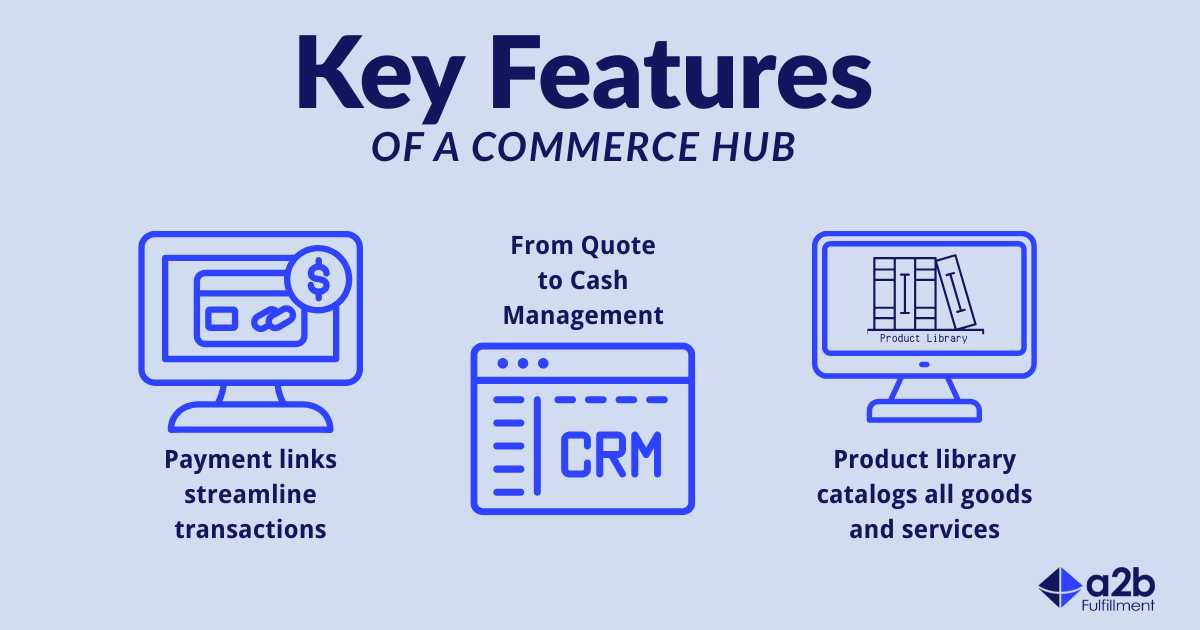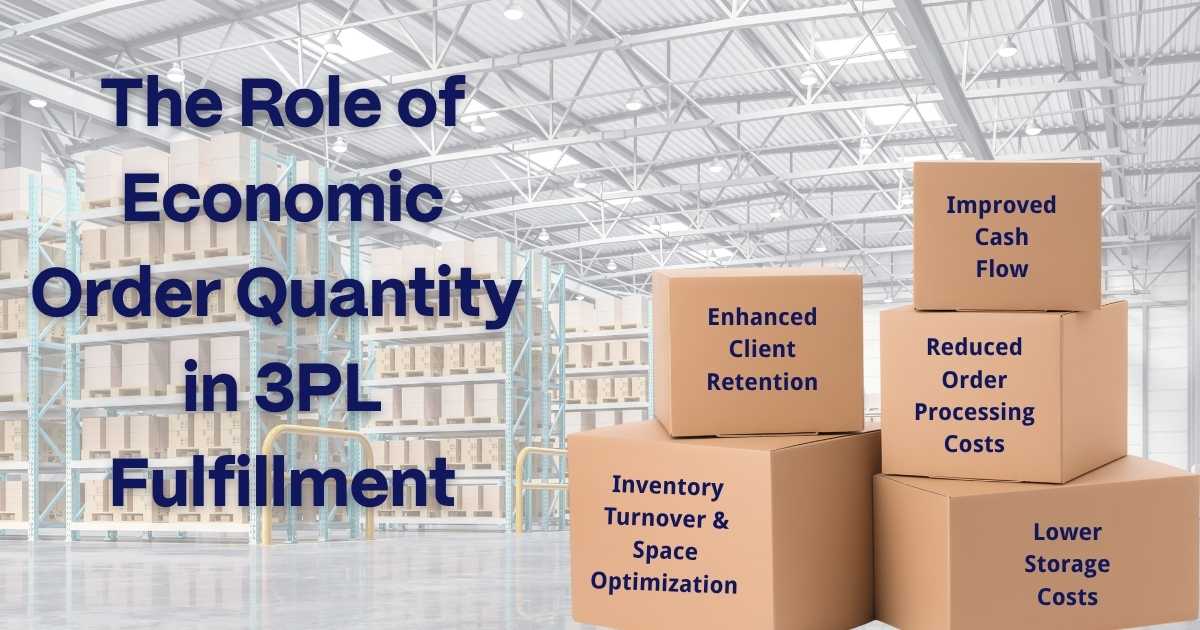Discover what a commerce hub is, including key features, the evolution, and the future of them in this a2b Fulfillment blog post.
Businesses need streamlined solutions to efficiently manage sales, payments, and customer relationships. Enter the commerce hub—a powerful tool that integrates various aspects of e-commerce into a single platform.
A commerce hub unifies payment processing, customer relationship management (CRM), and sales operations, enabling businesses to optimize their revenue streams and enhance customer experiences. In this blog, we will examine the main features of commerce hubs, discuss how they have changed over the last 25 years, and consider what the future may bring for these solutions.
Key Features of Commerce Hub Solutions

Commerce hubs are designed to simplify complex e-commerce processes, offering tools that empower businesses to sell smarter and get paid faster. Here are some standout modern features:
Payment Links
Payment links are a game-changer for businesses looking to streamline transactions. These secure, shareable links allow customers to make one-time or recurring payments via credit/debit cards, ACH, or digital wallets like Apple Pay and Google Pay. By embedding payment links in emails, websites, or invoices, businesses can reduce friction in the payment process, enabling faster transactions without requiring a full website checkout system. For example, platforms like HubSpot’s Commerce Hub allow businesses to create payment links directly from their CRM, ensuring seamless integration with customer data.
Quotes and Subscription Management
Commerce hubs excel at simplifying the quote-to-cash process. They enable businesses to generate professional, branded quotes directly from CRM data, reducing errors and saving time. Features like e-signatures and embedded payment links make it easy for customers to accept quotes and pay instantly.
Additionally, subscription management tools allow businesses to automate recurring billing, track subscriptions, and manage renewals effortlessly. This is particularly valuable for B2B companies offering ongoing services, as it ensures consistent cash flow and minimizes manual tasks.
Product Library
A robust product library is a necessity, allowing businesses to catalog their goods and services. Companies can track sales performance and gain insights into customer preferences by associating products with deals, quotes, or invoices. This centralized approach ensures accuracy and provides a clear view of what’s selling, helping businesses make data-driven decisions to optimize their offerings.
25 Years of Evolution
Over the past 25 years, commerce hubs have transformed from basic payment gateways to comprehensive platforms that integrate sales, payments, and customer management.
Simplifying Online and Mobile Payments

In the early 2000s, online payments were clunky, often requiring multiple systems and manual processes. Commerce hubs emerged to simplify this, offering integrated solutions for processing payments online and via mobile devices.
Today's platforms offer easy connections for payment processing. They include options like Stripe and other built-in solutions. These platforms support many payment methods and currencies. These advancements have made transactions faster and more secure, enhancing the customer experience.
Adapting to Ecommerce Trends
As e-commerce trends evolved, so did commerce hubs. The rise of mobile commerce, subscription-based models, and AI-driven automation pushed these platforms to adapt. Modern commerce hubs integrate with CRMs like Sales Hub, offering AI-powered quoting, automated billing, and real-time revenue reporting.
They’ve also embraced integrations with accounting tools like QuickBooks and Xero, ensuring businesses can sync financial data effortlessly. This adaptability has made commerce hubs indispensable for B2B and B2C businesses alike.
What Does the Future Hold?

The future of commerce hubs is bright, with emerging trends shaping their development to meet the needs of growing businesses.
Trends in Digital Payment Solutions
Digital payment solutions are evolving rapidly, with a focus on flexibility and security. Commerce hubs are expanding to support more payment processors beyond Stripe and HubSpot Payments, catering to global markets. Features like tokenized payments and advanced fraud detection will continue to prioritize secure transactions. Additionally, the rise of digital wallets and contactless payments will drive commerce hubs to offer more seamless checkout experiences.
Scalability and Adaptability in Commerce Solutions
As businesses scale, commerce hubs must adapt to handle increased transaction volumes and complex sales processes. Future commerce hubs will leverage AI to provide predictive analytics, personalized customer experiences, and automated workflows. Scalable solutions will allow businesses to expand internationally, supporting multiple currencies and compliance requirements.
Commerce Hubs and 3PLs – Harmony Achieved

Commerce hubs can integrate with third-party logistics (3PL) providers to streamline e-commerce operations. These integrations connect commerce hubs with 3PL services, which handle warehousing, inventory management, and shipping. This creates a seamless flow from order placement to fulfillment.
For example, platforms like CommerceHub specialize in connecting retailers with 3PL providers, enabling automated order routing, inventory syncing, and real-time tracking. Similarly, HubSpot’s Commerce Hub can integrate with 3PLs through APIs or third-party tools like Zapier, syncing order data with fulfillment systems. Specific 3PL integrations with 3PLs like a2b Fulfillment allow businesses to manage inventory, process orders, and track shipments directly from the commerce hub.
These integrations reduce manual work, improve order accuracy, and speed up delivery. However, the extent of integration depends on the commerce hub and 3PL provider, with some requiring custom API setups for full functionality.
Want to streamline your fulfillment with a commerce hub? Contact a2b Fulfillment to explore our integrated solutions!
Conclusion

Commerce hubs have revolutionized how businesses manage e-commerce, combining payment processing, quoting, and customer data into one unified platform. These solutions have evolved significantly over the past 25 years, from simplifying payments to adapting to modern trends. Looking ahead, commerce hubs will continue to innovate, offering scalable, secure, and AI-driven tools to help businesses thrive. Whether you’re a small business or a growing enterprise, a commerce hub can streamline your operations and boost revenue.
Ready to transform your e-commerce operations? Contact a2b Fulfillment today to explore our e-commerce hub solutions and start optimizing your sales process!






